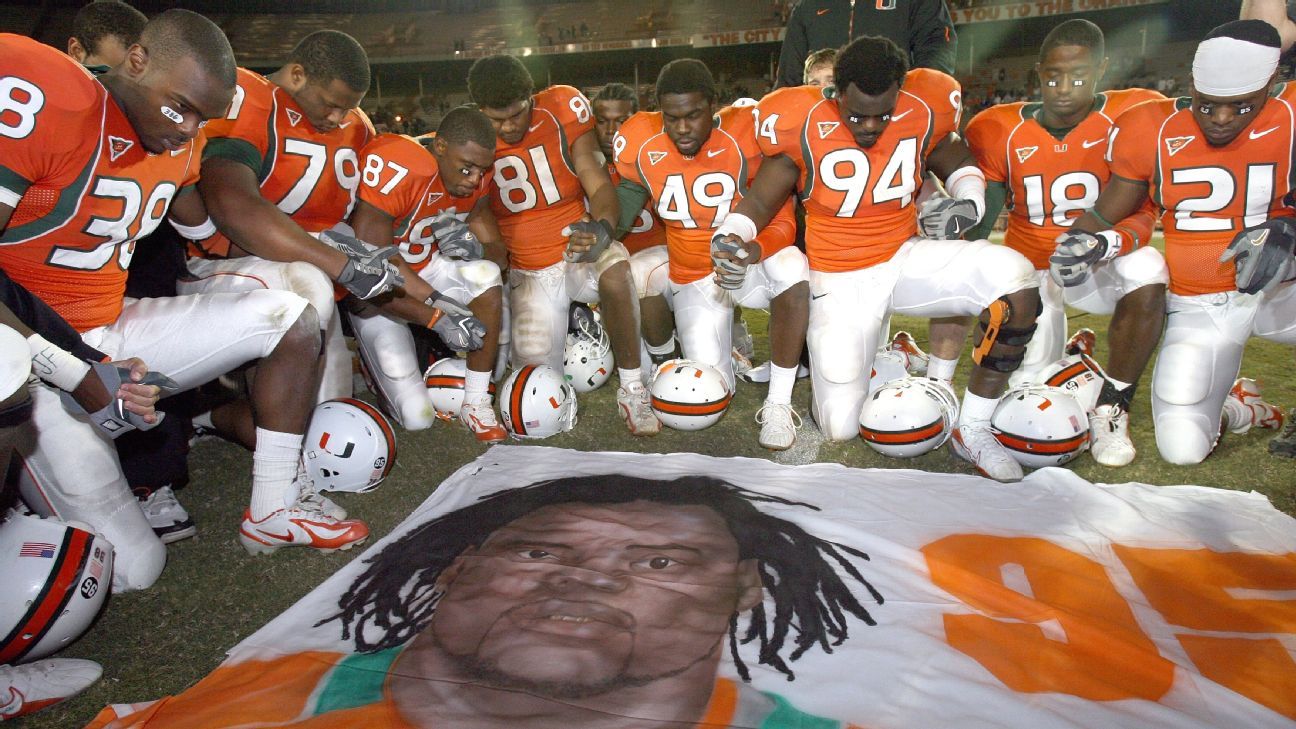A former Miami Hurricanes player accused in the long-unsolved killing of a teammate told a detective after his arrest last August that he understands why he was suspected, but he insisted he had nothing to do with the shooting death, according to evidence released to ESPN.
The videotaped statement by Rashaun Jones, 36, is the first time Jones is known to have answered questions about the death of Bryan Pata, who was shot once in the head outside his Miami-area apartment after football practice on Nov. 7, 2006.
Miami-Dade police brought no charges in the killing before an ESPN investigation in 2020 revealed that Jones had been a suspect since at least 2007. Jones was arrested last Aug. 19 and charged with second-degree murder. He has pleaded not guilty and is scheduled for a bond hearing Monday in which prosecutors plan to question two detectives, along with a former Miami football player who said Jones threatened him with a gun.
They also plan to question Paul Conner, a retired University of Miami writing instructor who told police the day after the shooting that he was approaching the north parking lot entrance when “he heard what he described as a ‘pop’ noise,” according to the police report. Connor also described “a black male, between 6’0″ and 6’1″ tall, who was wearing a black t-shirt and dark blue or black shorts, jogging or trotting west through the parking lot.” Seven months later, in June 2007, Conner picked Jones out of a photo lineup, according to documents.
In a videotaped interview from the day of Jones’ arrest, Miami-Dade Police Department Detective Juan Segovia laid out the evidence that he said pointed to Jones: testimony from players and associates who told authorities Jones was upset with Pata over a woman and had threatened him; a gun that police said Jones owned and had used to threaten others; phone records that police said show Jones wasn’t home on the night of the shooting, as he claimed; and testimony from an eyewitness who, police say, identified Jones as the man walking quickly away from the complex parking lot after the shooting.
Segovia also asked Jones why he changed his phone number on the day of the shooting and why he was the only player who didn’t attend a mandatory team meeting at the athletic department facilities that evening.
Jones said he was upset because then-head coach Larry Coker had told him earlier that day that he failed his second drug test and was suspended. Jones said he turned his phone off and then changed his phone number because he was worried about friends and relatives giving him a hard time.
“I know how that could look because of the situation,” Jones said in the videotaped interview. “But I’m telling you, I had nothing to do with him dying.”
“If you were the detective, who would be the first person you would talk to?” Segovia asked.
“Probably me,” Jones said.
Jones said he and Pata had quarreled over Pata’s girlfriend, who had previously been in a relationship with Jones, and once fought at a teammate’s house. “I got up from there and went downstairs. I might have cried a little bit, but it wasn’t any ongoing beef where I was at Bryan or trying to hurt Bryan,” Jones said in the interview. Jones said the fight happened in summer 2005, but players told ESPN in prior interviews that the fight was in summer 2006.
Jones twice referenced a home football game shortly before Pata’s death in which Jones said he helped Pata, who was in uniform and pads, by kneeling down to tie his shoe.
“If I’m beefing with somebody and I want somebody dead, why am I tying their cleat for? I’m literally down there tying his cleat,” Jones said.
Segovia repeatedly asked Jones if he had any reason to be near Pata’s apartment that night – noting the phone records and eyewitness who picked Jones out of a lineup. Jones answered each time that he was at home. Jones said he knew where Pata lived because he was friends with Pata’s cousin, who lived in the same apartment complex, and he would occasionally go to her place for dinner, but not that evening.
Segovia also told Jones that police had testimony from witnesses who said Jones had a gun, talked about owning a gun, and threatened another player with a gun in a separate incident. Jones said all three were lies.
When Segovia asked him how all this testimony could align with cell phone location records showing Jones wasn’t home, even though he said he was, and a man who identified Jones in a lineup as someone walking away from the parking lot, Jones just said it was “bad luck.”
“I can’t explain to you. I don’t know. Just really bad luck, really bad. Look, I’m telling you. I have nothing to do with this guy being murdered, nothing. It ain’t no 15 years of telling myself I didn’t do it,” he said.
Jones said it “was unheard of” that police would sit on information from an eyewitness for 15 years, and he asked why they didn’t confront him with that information sooner.
“Because cases take time to evolve, they take time to develop, we want to make sure we get things right,” Segovia said. “We want to make sure people are still cooperating.”
